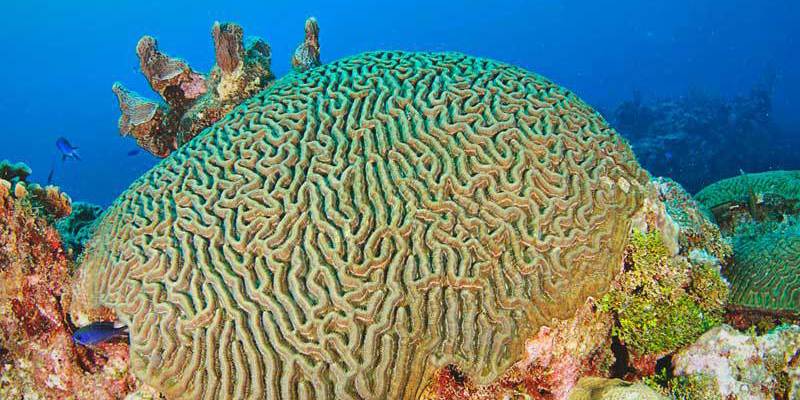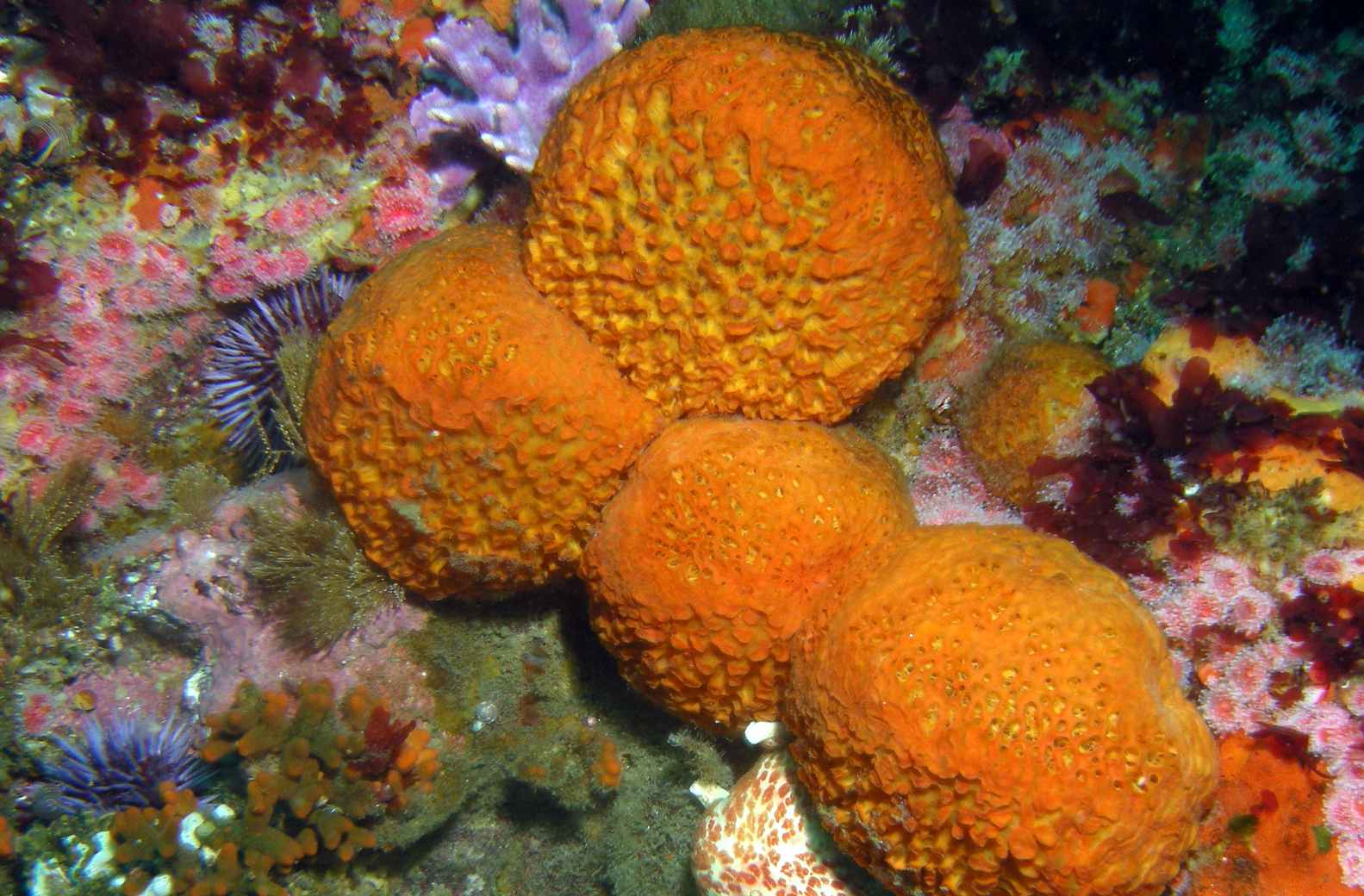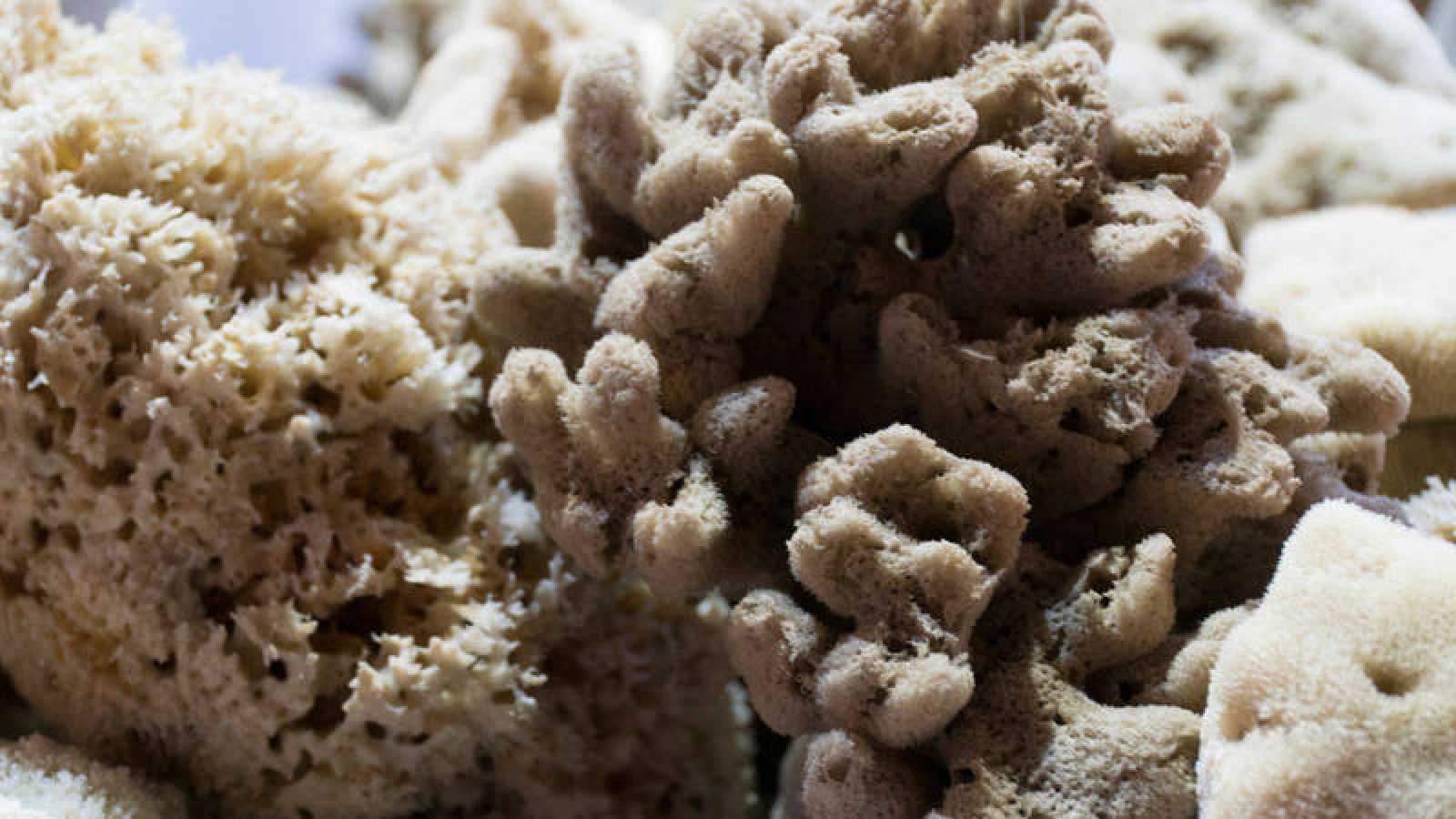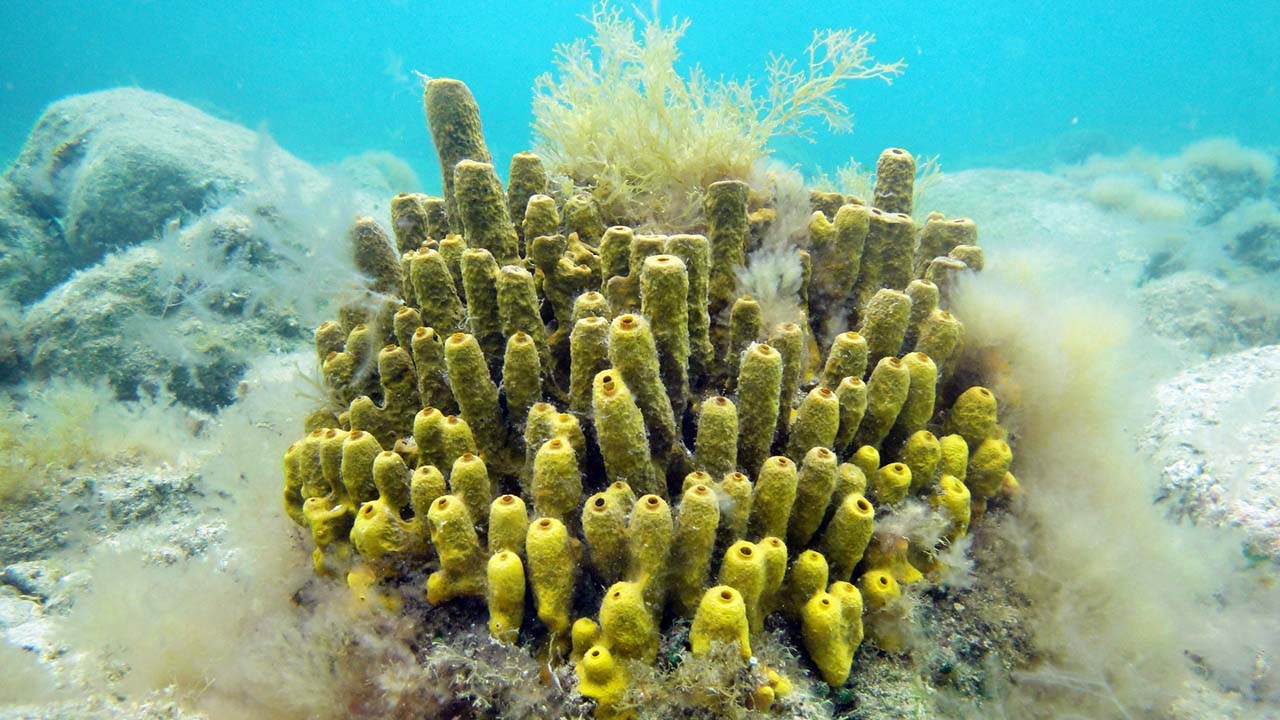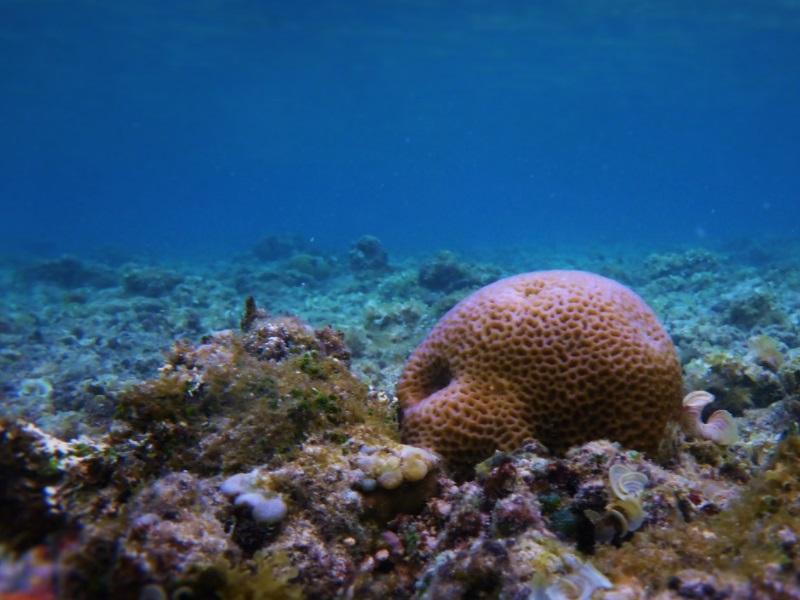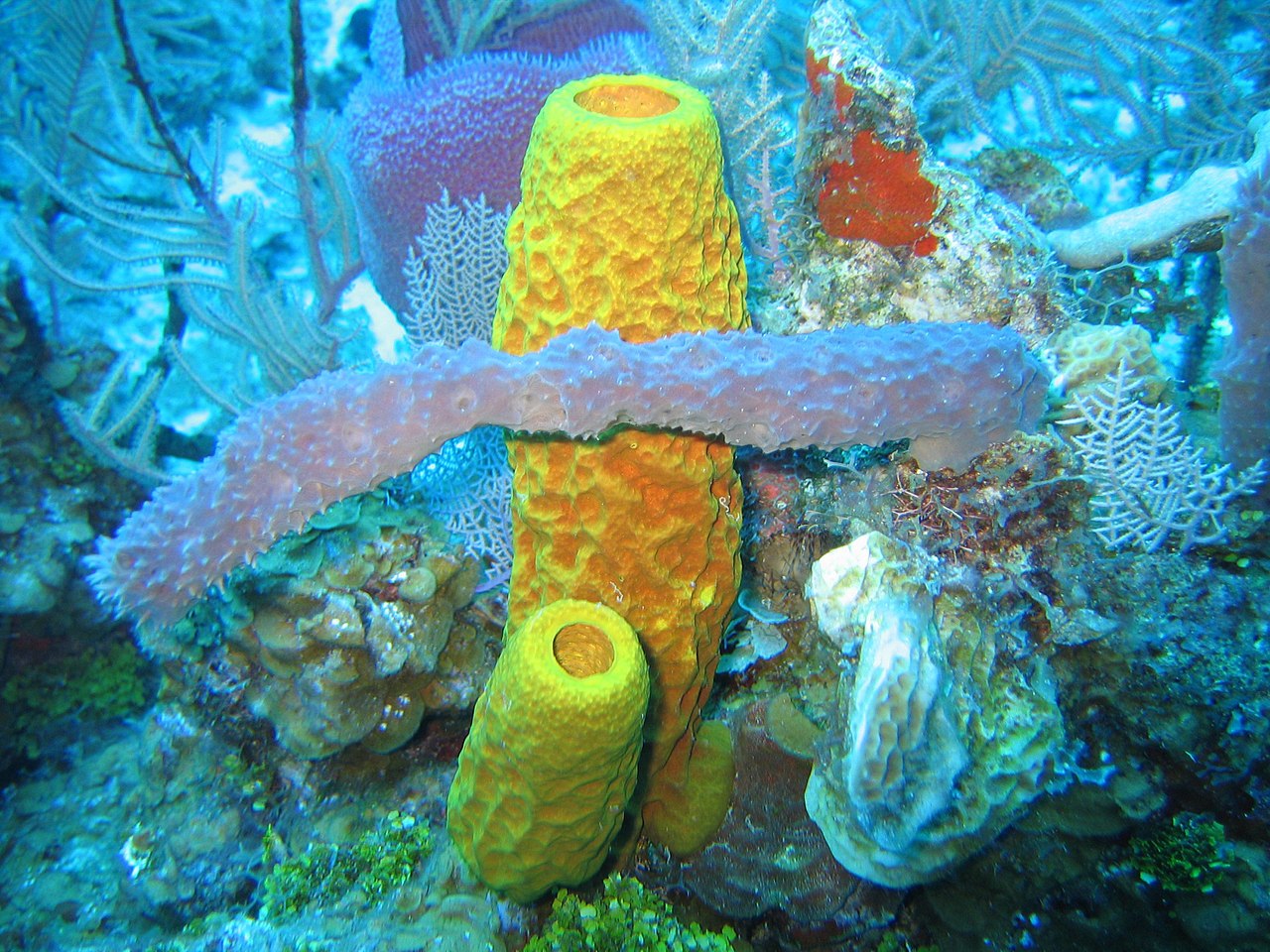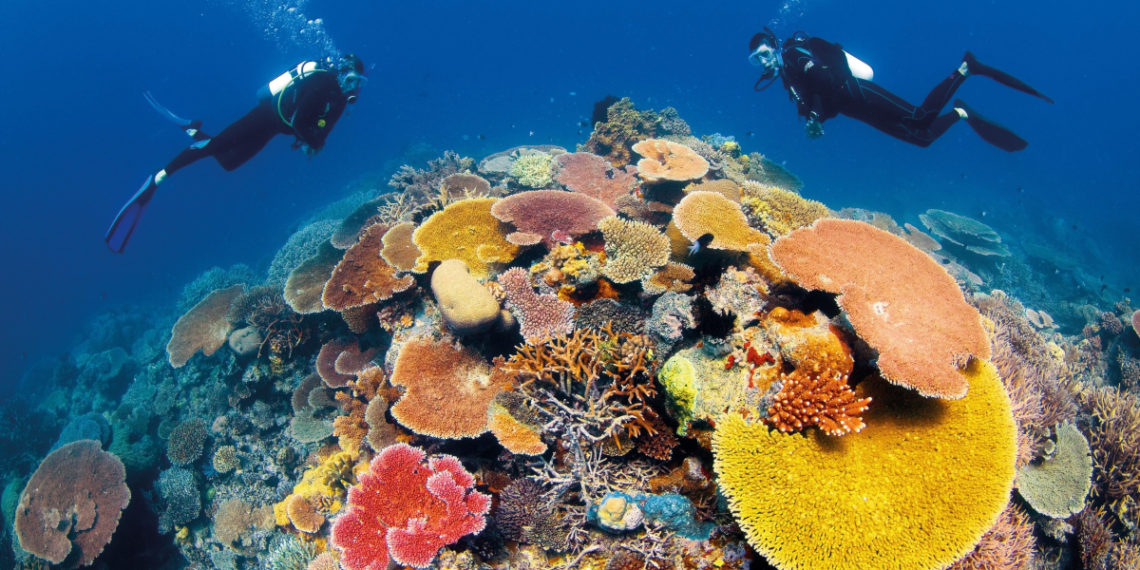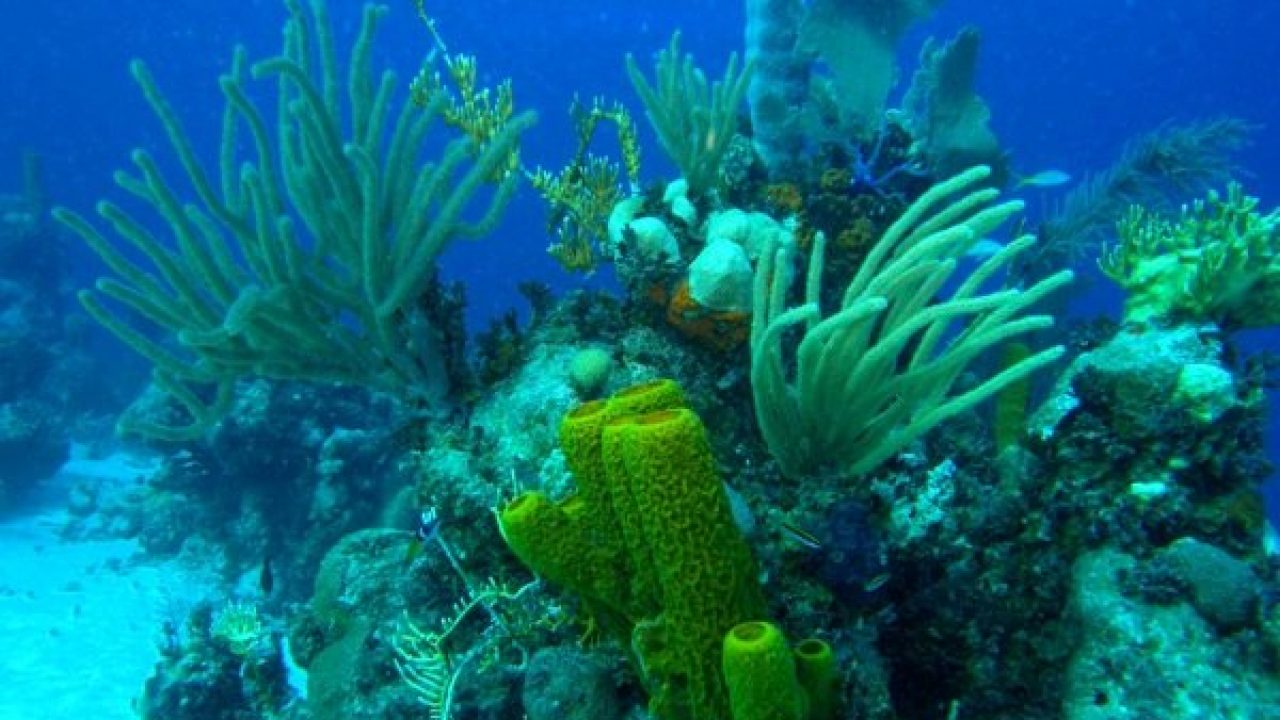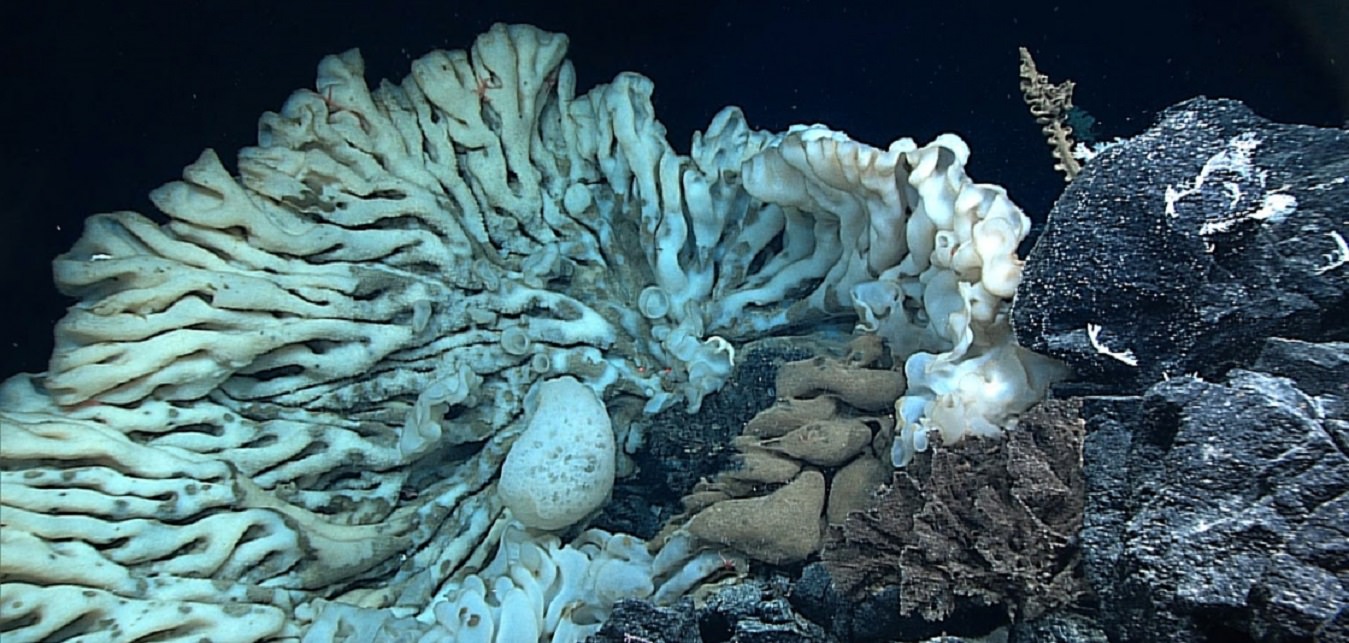Sometimes it can be thought that the more sophisticated and complex a system is, the longer it will last and the better its performance; In the animal kingdom this is in question with respect to Sponges, in relation to the fact that it is a living being that fulfills a very important function within a vast aquatic ecosystem, being of a simple structure and evolving over thousands of years.

What are Sponges?
Also called poriferaporifera), corresponding to a group of invertebrate animals that live in water, belonging to the varied Parazoa subkingdom. They are mostly marine, lacking movement and do not have real tissues, being also filter feeders thanks to a unique system of pores, chambers and channels that can produce water currents caused by choanocytes.
Around nine thousand species of sponges are known around the world, only one hundred and fifty of them living in fresh water. According to scientific studies, the origin of sponges was known through the discovery of fossils (hexactinellide), dating from the Ediacaran Period (Upper Precambrian).There was a time when they were considered plants, and this was mostly because of their immobility, until in 1765 they were correctly recognized as animals.
They do not have organs to digest, however, this is intracellular. It should be noted in an important way that sponges are the sister group of all other beings that belong to the animal kingdom, in addition to that, they are considered the first forms to extend from the evolutionary tree from a common living being of all animals, being one of the simplest, but effective life forms without having an organ.
Characteristics of Sponges
Sponges are living beings that have many interesting characteristics that make them one of the strangest but most fascinating species. Within this order of ideas, it begins by indicating that the cells that form the exoskeleton are totipotent, which means that they can be converted according to the requirements of the animal species, with specific cellulose characteristics. Therefore, the organization of these is not tissue (with tissues) but corresponds to a completely cellular organization.
It is observed that the general shape of the sponges is similar to that of a bag, with a large cavity at the top, the osculum, a space through which the water circulates out of the sponge, and a number of pores of various sizes, found on the walls, which is where the water seeps into it. A different case occurs with feeding, which occurs in an internal space of the animal, developed in it by a specialized cell type and particular to the species, the choanocytes.
In the following video you will be able to know the origin of the life of sponges:
These cells bear a strong similarity to choanoflagellate protozoa, making it evident that they are closely linked phylogenetically. The Pomiferans, which are the most primitive of the single-celled animals, probably had a common starting point with the colonial choanoflagellates, similar in part to the recent ones. proterospongia o sphaeroeca.
Sponges are totally unable to move; many do not have the same proportion in their skeleton, resulting in them not having a defined shape; there is a species that grows indefinitely until they collide with another developing sponge or another obstacle, others that embed themselves in bedrock. The species can have different aspects due to the environment where they are found according to the environment where they are found, the inclination of the substrate, areas and water availability.
However, more precise studies have found that certain sponges move on the seabed or the base where they are from one part to another, but very slowly, since it moves about four (4) millimeters a day. What it excretes is essentially ammonia, and gas exchange occurs by simple expansion, primarily through the choanoderm, an important part of the sponge's anatomy.
Not only can the appearance be varied, so can the colors. Pomiferous found at the bottom of the sea have a neutral, brown or grayish color, and those closer to the surface have more striking colors, ranging from red and yellow to purple and black. Most of them are calcareous (which have lime), they have a white color, but they take on the color of the aquatic plants that live inside them, making a symbiosis.
Those that have a violet color are those that contain plants with blue and green pigments, also symbiotic, however, when darkness arrives they turn white since the photosynthesis process does not stop occurring. The firmness of sponges can also be random and can range from a slimy, whitish condition, to a solid, rocky appearance of the genus petrosia. The space can be smooth, velvety, rough, and have many conical protuberances called conules.
The lifespan of sponges is unknown, but to make a good approximation of that, small encrusted forms are on the average one year old, and then leave in an inauspicious season to exist, although, small parts of a whole may maintain and manage to reproduce, according to the season. The famous bath sponges (hypospongia), to name a few, reach a pleasant size after seven years of growth, having a lifespan of two decades.
Fundamental groups of Sponges
It so happens that sea sponges have been evolving for about five hundred million years, and there are currently around five thousand known and classified species, but it is still believed that there are still 5.000 species yet to be known. Most of the sponges live in the open sea and only the group Spongillidae They inhabit fresh water, such as rivers and lakes.
The first classification made to the pomiferas by some naturalists was that of aquatic plants, since they do not have organs and do not move at all, just as the rest of the animals do, but recent molecular research infers that both animals Like sponges, they changed and molded themselves into their different designs, drawing from a common ancestor pattern. From this determination, they could be grouped into various classes, the following being in force:
Calcareous class (Current- calcareous sponges): They are corpuscles that have from one to four rays, composed of crystallized calcium carbonate, arranged in the form of calcite. There are three types of organization for it and, in general, they are found in shallow coastal waters and with a high incidence of light.
Class Hexactinellida (Current- vitreous sponges): Siliceous corpuscles, composed of hydrated silicon dioxide, which have between three and six radii, and are generally found in deeper waters, between four hundred and fifty and nine hundred meters, with medium incidence of the light.
Class Demospongiae (Current – demosponges): Siliceous corpuscles, composed of hydrated silicon dioxide, with more than six rays, which can be replaced by a set of fibers arranged in the form of a mesh. They have a leuconoid cell organization and can live at any depth.
Archaeocyatha (Extinct-Repealed): Refers to a non-existent group of uncertain location related to the pomiferous, which did not inhabit the marine ecosystem for a long time. They were 50 million years ago on Earth, while the Cambrian period lasted. It is believed that they were in waters with great depths.
Sclerospngiae (Repealed): This classification lasted until the 90s. Within this group were sponges that create a hard, rock-like matrix of calcite, known at this time as coral sponges. The fifteen known forms of sponges were reclassified into the classes calcareous y demospongiae.
Anatomical description of sponges
Like all animals, this type has a particular coarse anatomical system. Next we will describe in depth how it is.
pinacoderm
Externally, sponges are protected by a layer of pseudoepithelial particles of different sizes, called pinacocytes; they are not comprised of authentic epithelium, since they do not have a basal lamina. This group of particles generate the pinacoderm (ectosome) that is related to the epidermis of the eumetazoan species, since it is passing through several superficial pores, each one covered by a particle called a porocyte; affect the interior to be attracted by water.
Choanoderm
The internal space of a sponge is covered by many flagellated cells which, grouped together, make up the choanoderm. The main central opening is the atrium, where the flagellated cells produce the displacement of water, being fundamental in feeding. These particles can have the thickness of a cell of the asconoid type, being able to fold, like those of the siconoid type, and in turn, subdivide to create clusters of spaces formed by independent choanocytes.
mesohilo
Under these two covers there is an organized space of soft consistency, where the mesophyll exists, through which support fibers, skeletal corpuscles and an endless number of amoeboid cells of important weight in what corresponds to the digestion, suppuration of the skeleton, can be found. elaboration of gametes and the mobilization of nutrients and wastes. The components of the mesohyl are internal.
exoskeleton
Within the mesohil there are countless flexible collagen fibers, which comprise the protein part of the skeleton and siliceous (hydrated silicon dioxide) or calcareous (calcium carbonate) corpuscles, all according to the classification in which it is found, they are the part important mineral, since they give it solidity. The strength and hardness of this wall may be different, depending on the amount of protein or minerals.
Collagen strands tend to have two unique natures, one being loose, thin fibers and the other being spongin fibers, which are thicker. Both are placed in a framework, being crossed with each other and with the corpuscles as well, being able to enclose grains of sand and parts of the sediments left by the spicules, whether siliceous or calcareous.
The calcareous corpuscles have little variation in their shape, the opposite being the case for the siliceous spicules, which are diverse both in their size and in their morphology, being able to differentiate the megascleras (greater than 100 μm) from the microscleras (less than 100 μm). Periodically, both the spicules and the fibers are not randomly placed, but rather have a specific order.
Important Particle Types
Within the most general perspective, sponges do not have their own tissues or organs, which would represent a great difficulty for any animal to exist and, above all, for the different functions to be carried out inside them. For the pomiferas this does not represent a problem, since they are carried out by different cell forms, which can exchange information with each other.
These are described as:
pinacocytes: This type of particles form the outer cover of a large part of the sponges. They are able to protect, as well as phagocytize or digest.
Basopinacocytes: They are special cells, located in the seat of the sponge, that expel filaments that allow the pomiferous to embed itself in the substrate.
porocytes: They correspond to the cylindrical particles of the pinacoderm, which have a central opening that is regulated, allowing the passage of a greater or lesser volume of water towards the internal part. They are only possessed by calcareous sponges.
choanocytes: Basically, they are the most abundant cells in sponges. They have a long central mobile filament, composed of a single or duplicated crown or collar, with microscopic villi intertwined by mucous filiform bodies that make up a reticulum. The flagella, directed towards the internal spaces capable of allowing the locomotion of the cells, produce water currents according to displacements with a defined direction, but of variable time.
Watch the following video documentary about sponges:
Colenocytes and Lophocytes: Mesophyll particles that produce randomly arranged collagen fibers, becoming intertwined to form a support in the mesophyll, which help both the transport of other cells and reproduction.
spongiocytes: Particles contained in the mesohyl, which produce thick collagen fibers, also called spongin fibers, whose function is to be the main support of the body of several pomiferas, as far as their structure is concerned.
sclerocytes: Cells that are related to the creation of the corpuscles, both calcareous and siliceous, and disaggregate when the secretion of the spicule is finished. They also influence the various forms that these can have.
myocytes: Particles that can shrink, located in the mesohyl, located around the osculum and the main openings. The cytoplasm it contains has many microtubules and microfilaments. The response of these microorganisms is not rapid, without electrical impulses that condition them, as they do not have nerves or nerve cells.
archaeocytes: Mesophyll particles, which have the potential to transform into any cellular form. They have a great influence on the digestive process, having cells digested by choanocytes, being the means of excretion and transport of sponges. They are essential in asexual reproduction.
spherulous cells. They fulfill functions in the excretory system and accumulate small grains that refract light and expel them into the circulating stream.
Classification of Sponges according to their filtration capacity
According to their organization and their filtration capacity, the sponges are organized into three levels, which allow the vast increase in the surface of the choanoderm, and gradually, also increases the efficiency in filtration, going from the simplest to the more complex, which represents an important aspect not only in feeding but also in its regeneration and reproduction. These are:
asconoid: Tubular pomfera, with small rays, less than ten centimeters, with a central space, called spongiocele or atrium. The locomotion of the choanocyte filaments allows the entry of water into the aforementioned space, through the pores that pass through the entire body wall. The choanocytes, which cover the spongiocele, trap particles found in the water.
Syconoid: They have a radial shape, like the asconoid. The body wall is thicker and more complex than the asconoids; the choanoderm, also forming part of the covering of the atrial space. They present cylindrical cavities, areas covered with choanocytes that expand into the spongiocele through a pore called apopilo. The water current passes through the inlet channels through a large number of surface pores, then passing through the prosopyles.
leuconoid: This type of sponge, which has a leukonoid organization, does not have symmetric circular openings, but rather has smaller atrial canals and a large number of vibratile spaces, globular areas covered with free choanocytes and with different directions, found in the mesohilo , although with communication between them, both with the outside and with the osculum through a group of channels, which allow respiratory activities, in this case, filtering.
How do sponges eat?
At the beginning of this interesting point, it should be noted that sponges lack a mouth and a digestive system, being different from the rest of the metazoan group, since they depend on a fascinating intracellular digestion, allowing phagocytosis and pinocytosis to be the mechanisms used to be able to eat food. In addition to this, they do not have nerve cells, they are animals that do not have a nervous system.
Porifera pass water through their openings to get their food and collect as much oxygen as possible. Knowing that sponges do not have a stomach, specialized cells are responsible for feeding these living beings. The particles are known as choanocytes and archaeocytes, in which the former are responsible for trapping all the food and the latter digest it inside.
Making a modest comparison of the diet of the sponges with that of the human being, there is a great advantage for the former in that the former mentioned above had a large number of tiny or reduced-sized mouths throughout the length of their mouths. its way. Through these channels or pores, the water enters and is taken to the core or central space, and then be expelled through an upper hole.
In order to summarize the process, it is summarized as follows: the water, with a large number of particles, is filtered into the sponge through the pores. At that instant, large particles (between 0.5 μm – 50 μm in diameter) are digested. In other words, there are specialized cells that absorb and feed on these particles, and the water with the smaller particles passes into the interior cavity of the porifera, where they are also digested, forming part of a precise process.
The sponges are always allowing the constant passage of water through them and, several large species are of these, they are capable of filtering an amount greater than a thousand liters of water per day; It is interesting to know that this living being does not depend on a very complex system to be able to feed itself and to be able to exist in the sea, unlike other animal species that do have a more complex system.
Knowing about the reproduction of sponges
Now, you're probably wondering how sponges reproduce. In this section we answer it:
Asexual reproduction
Given the great capacities of their cells, all porifera manage to reproduce asexually from pieces. A large number of sponges produce buds, small prominences, similar to bumps on the human being, which are able to detach, and in certain cases they keep essential food within themselves; some freshwater species (known as Spongillidae) manage to produce complex embryos, similar to correctly placed spheres with archaeocytes.
In this regard, they have protective layers, one of them thick, made of collagen supported by amphidisc-type corpuscles, which tend to be very resistant to large changes in temperature and the environment, such as periods of drought and winter ( they can withstand up to -10 °C). It is known that several marine species produce this type of gemmules, but simpler, called soritos.
Sexual reproduction
Without a doubt, sponges do not have an internal or external reproductive system, but that does not prevent certain species from reproducing sexually. Gametes and embryos are located in the mesohyl. The large group of porifera are hermaphrodites, however, they do not have an established pattern, reaching the point where, in the same type, different groups of hermaphrodite species can coexist with dioecious individuals. In this sense, fertilization is mostly intertwined.
Sperm cells originate from choanocytes, when all of a space are affected by spermatogenesis and form a sperm bulge. The ovules, starting from either choanocytes or archaeocytes, are surrounded by a layer of food particles or trophocytes. The masculine gametes and the ovules are thrown to the outside by means of the currents of water; in this part, fertilization is carried out, giving rise to planktonic larvae.
For some types of sponges, the sperm affect the aquatic environment of other poriferous beings where they are digested by choanocytes; then, these parts separate, to later transform into amoeboid cells, called phorocytes, which lead the male gamete to an ovule that can fertilize, and thus, the larvae are released by water currents, until the cycle is completed.
Under the aforementioned characteristics, four important types of essential larvae for sponges can be briefly described during the sexual reproductive cycle:
Parenchymule: It refers to a compact larva, which has a layer of monoflagellate particles on the outside and an important group of cells with a great resemblance to archaeocytes, found inside.
coeloblastula: It corresponds to a fairly light larva, also made up of a layer of monoflagellate particles, which surround a large internal space.
stomoblastula: It is composed of celloblastulae, typical of the porifera that incubate the fertilized ovules in their mesohilo. It also tends to be quite light, but contains some larger cells (macromers) that allow an open space, which connects with the internal space. It is affected by a large reverse process in which internal flagellated particles become external.
amphiblastula: It is the product generated from the reverse process that occurred in a stomoblastula. It is made up of a hemisphere, made up of large, non-flagellated cells (macromers), the other being with small, monoflagellate particles (Micromers). This larva is expelled and ends up adhering to the base through the micromeres; they are grouped forming a volume of flagellated particles, the macromeres form the pinacoderm, following that, it is possible to expand towards an osculum.
Returning to the above, when it is opened, a small leuconoid sponge is generated, which is known as an olynthus. The larva has to seek to descend for a certain time, which can be a few days or a few hours, to locate a suitable area for its placement. After joining it, the larva transforms into a young poriferous, causing a total change in its structure, as well as in its exoskeleton.
Watch the reproduction of sponges on video:
The stage where sexual reproduction is conducive depends fundamentally on the temperature of the water where they are found. In areas that are at room temperature, they manage to mature between the spring and autumn stages, and in quite peculiar cases, two reproduction periods take place, one in each particular season of the year. The stage of reproduction may be different for other species, citing among them the cliona, tetya and scypha, occurring at any time of the year.
Sponge Habitat
Under their body structure (channels that allow water to filter), sponges are found in any body of water, regardless of whether it is fresh or marine, placing themselves next to a strong substrate, however, certain species can adhere to soft bases such as mud or granular soil. Most sponges prefer to be exposed to little or no light; They feed mainly on organic particles of microscopic size that are suspended.
These species are also able to feed on bacteria, dinoflagellate compounds and microscopic plankton. Its filtering potential is amazing; A leuconoid Pomfer ten centimeters high and one centimeter in diameter contains around two million two hundred and fifty thousand flagellate spaces and allows the passage of twenty-two and a half liters of water per day.
Despite their simple configuration, the sponges promote a positive impact on the ecology; These animals manage to dominate a large number of fairly muddy marine habitats and can withstand pollution due to the effect of gas, oil, strong minerals and chemical products quite well, collecting these pollutants in large groups without causing them any collateral damage or affection.
Certain pomiferas have photosynthetic symbionts, such as cyanobacteria, zooxanthellae, diatoms, zoochlorella, or perhaps simple bacteria. They constantly release symbionts and organic particles, producing substances of mucous order in a defined time. For some sponges, the symbionts, according to statistics, can represent up to 38% of their body volume.
The truth is that the group of animals that feed on sponges is quite small, and this thanks to their exoskeleton of corpuscles and their high toxicity, within which there are few opisthobranch molluscs, echinoderms and fish. Periodically, they are punctual species that have been exclusively spongiophagous, that is, they can digest the pomiferous, and they hunt a clear species of sponge.
All of these have an impressive variety of toxic substances and antibiotics that are used so that they cannot hunt them, nor feed on the substrate where they live. Certain substances or compounds that sponges possess are pharmacologically useful, having cardiovascular, anti-inflammatory, antiviral, gastrointestinal, antitumor functions, among others, which are under intense analysis, being able to name among them arabinosides and terpenoids.
The common thing about this species is that they settle and grow in rocky or hard areas, others manage to adhere to a soft surface such as sand, mud or even debris around them; one of the rarest types of sponges are those found in a loose state. Various invertebrates and fish use them as their refuge thanks to their cavities and internal spaces, although there are also gastropods and bivalves that have them embedded in their shells, as well as various crabs. Gives advantages to both.
How do sponges regenerate?
These aquatic beings have the amazing ability to regenerate both damaged and lost parts, as well as being able to fully restore themselves into an adult, starting with small parts or even individual particles. Cells have various methods to achieve separation, either by mechanical means or by specific chemical processes.
These cells manage to be in movement when they migrate and become part of active aggregates in which archaeocytes play a fundamental role. In order for the tiny pieces of cells to increase their size, they must manage to join a space where they expand their volume when they flatten, becoming a layer of pinacocytes, called diamonds, and in the spaces where the choanocytes are found, as well as the channel system, a new functional sponge is generated.
Regeneration cannot be compared with the process of sexual reproduction, since the different types of cells that are separated participate in the composition of the sponge in question, organizing and reconstructing themselves, instead of classifying themselves before the primitive cell types. . The regeneration process of pomiferas has considerable scientific relevance in terms of the intracellular process that occurs within it, adhesion, ordering, as well as movement and its properties.
Relationship of the Sponges with the human being
Sponges make up the ancestral group of living animals. In relation to fossils found and analyzed, they have been on Earth since approximately five hundred and forty million years ago, close to the Precambrian-Cambrian boundary, just when the Ediacaran faunal period was coming to an end, a determination that gave a new trial to this species within the scientific community.
The proceeding analysis indicates that the first inhabitants of the Mediterranean already used the very famous bath sponge; it is believed that the first civilization who made use of it were probably the Egyptians. The great Greek philosopher, Aristotle, knew of the existence of sponges and described how they could easily regenerate. Roman soldiers used sponges instead of metal cups to drink liquids, but used more to drink water during military missions, and sponge fishing was one of the disciplines of the ancient Olympic games.
It is thus known that various species within the sponge family have been used by multiple civilizations and cultures in the past through their strange elastic and soft skeletal writings like the species of the class demospongia, to cite some, being others the spongia officinalis, Spongia Zimocca, Spongia Graminea and Hippospongia communis, used to clean household household objects.
At the time when the Greek and Roman civilizations were at their height, they were used to place paint, as objects to clean the floor, even as glasses for soldiers to drink liquid. Now, speaking of the Middle Ages, it is recorded that the sponge was used as a medicinal tool to treat soldiers and royalty, as a resource in various conditions and illnesses.
Today, the use of sponges is very wide: they can be used in art and in various trades such as decoration, jewelry, painting, pottery and surgical medicine, when performing an operation. In every home there is a sponge, although at present natural sponges have been replaced by manufactured and synthetic poriferous, this having a positive impact on the environment.
Between the seas and the lands of the North Atlantic, sponges brought by the sea to the shore of the beaches have been used for generations as a powerful fertilizer for crop fields. However, the greatest potential and economic category of this, contemplate the bath sponges, more than all, the classes sponge e hypospongia, whose exoskeleton is only hard and elastic.
It is important to know that, for a long time, the great market for sponges has been focused on the lands of the Eastern Mediterranean, in the Gulf of Mexico, continuing in the Caribbean, in northern latitude towards the coasts of the American Atlantic and the Japanese coasts. In the state of Florida (United States) there was previously the most important manufacturing industry in the world, according to the fact that, during the fourth and fifth decade of the XNUMXth century, uncontrolled fishing and various diseases drastically reduced the production of sponges.
Life risk of sponges
Knowing that sponges are vital for the entire environment and ecosystems, it has not yet been possible to make any proof of their risk to life worldwide, at present. It is explained that most of the porifera do not seem to be at risk globally, as others claim. However, there is not a large amount of information on the large number of species and more data needs to be collected and analyzed, obtained under a rigorous study on the incidence of anthropogenic pressures.
We invite you to visit the following articles of interest:
- Aquatic animals
- Marine animals
- Land animals

